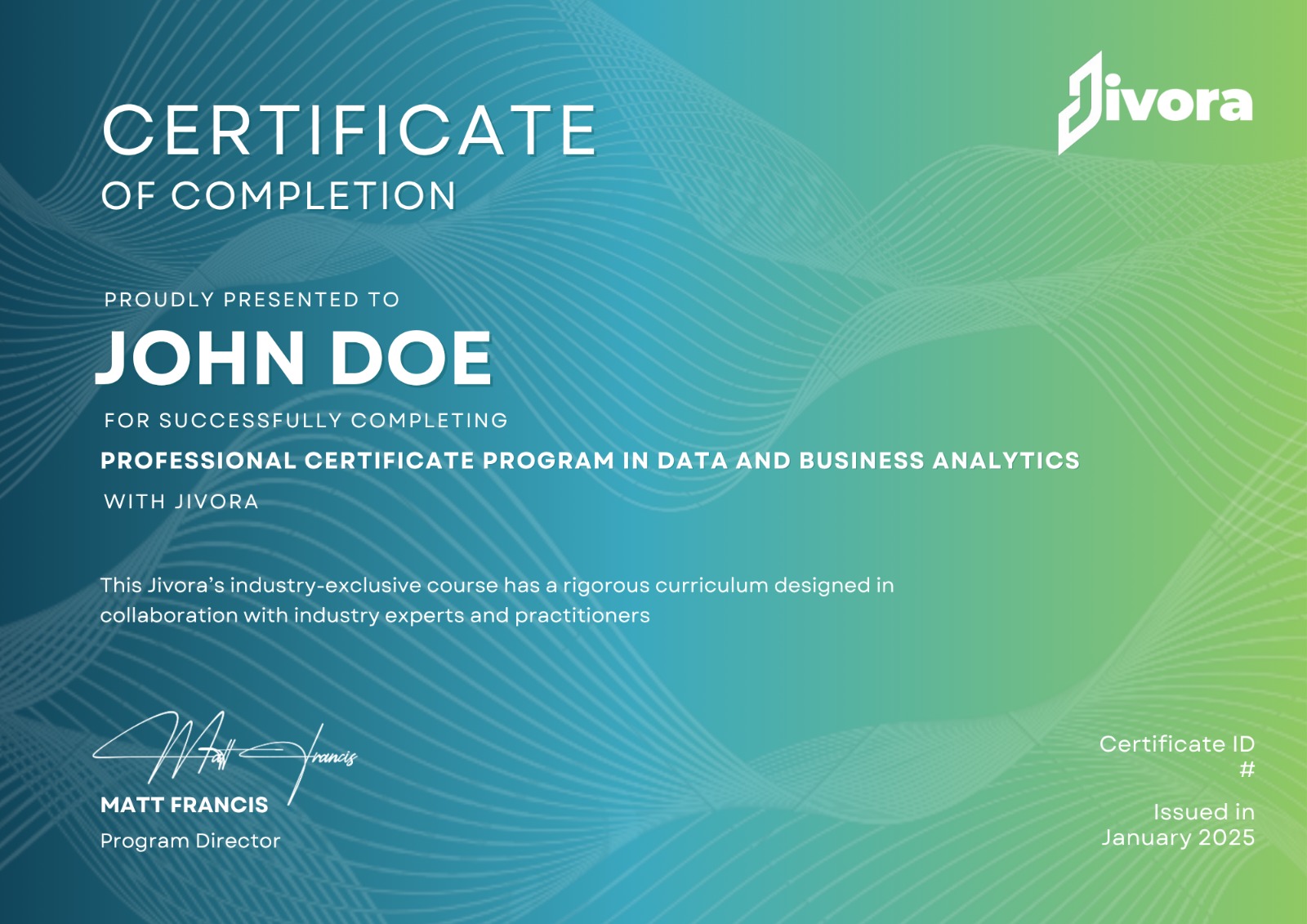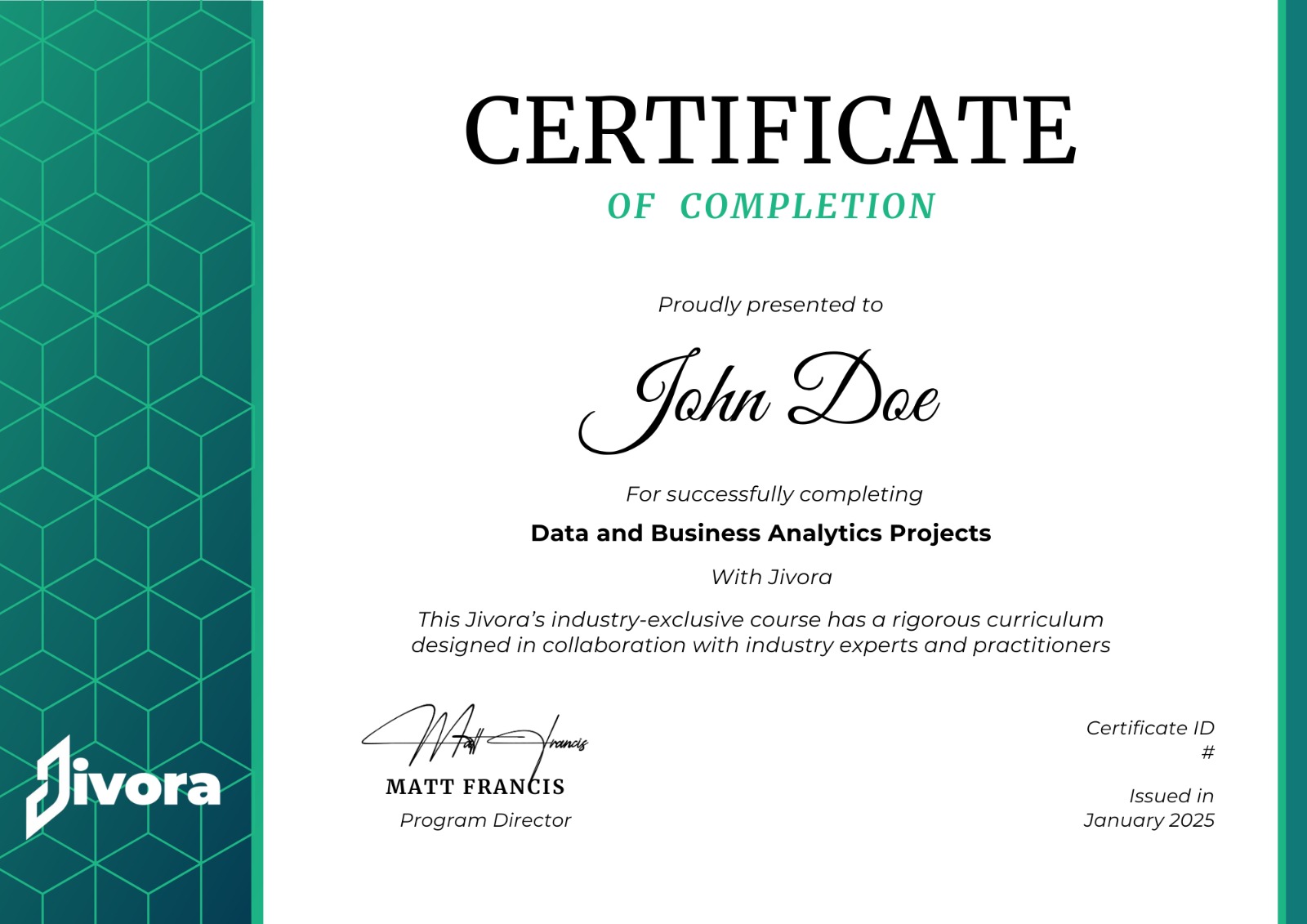
in collaboration with

Unlock your future with Jivora’s Data and Business Analytics program—a comprehensive 6-month course designed to make you industry-ready. Gain in-demand skills in data visualization, business intelligence, statistical analysis, data-driven decision-making, and tools like Excel, SQL, Python, Power BI, and Tableau—all through hands-on projects and expert mentorship.
Whether you're starting your journey or looking to upskill, Jivora’s Data and Business Analytics certification equips you with practical knowledge, a strong portfolio, and the confidence to thrive in today’s data-driven business world.
Join Jivora’s Data Science and AI program today to gain cutting-edge skills, real-world experience, and the confidence to launch a successful career in the rapidly growing tech industry.
Excel
Excel, developed by Microsoft, is a versatile spreadsheet tool used to organize, analyze, and visualize data. With its wide range of functions, including formulas, tables, and charts, it plays a vital role in effective data management for businesses.
Introduction to Excel
Fundamentals of Excel
Data Exploration with In-Build Function
Basic Visualisation Analytics
Charts and Graphs
Advance Excel
Advanced Excel extends beyond fundamental features, allowing for detailed data analysis through advanced formulas, pivot tables, macros, and automation tools. It equips professionals with the ability to manage and analyze data accurately and efficiently.
Functions
Look Up
Vlookup, Index, Hlookup
Date Functions and Time
Data Tables and Validation
Pivot Table
Financial Functions
Micros & Coding
Custom Formatting and Advance Filters
Story telling & dashboard creation
Storytelling and dashboard creation are essential skills in Data and Business Analytics that enable professionals to transform data into clear, impactful narratives. By integrating key information into visually engaging dashboards, analysts can effectively communicate insights, support informed decision-making, and deliver presentations that drive business impact.
Data Storytelling & Stakeholder Engagement
Dashboard Design & Visual Communication
Creating Advance Dashboard
Develop a solid grounding in data and business analytics by learning SQL for effective data handling and exploring key principles of probability and statistics. Gain the ability to turn raw data into meaningful business insights using Power BI through interactive dashboards and impactful visualizations. This module equips you with the critical skills and tools needed to analyze, interpret, and communicate data effectively to support informed business decisions.
Master both the fundamental and advanced aspects of SQL (Structured Query Language), an essential skill for professionals in data and business analytics. This module emphasizes efficient querying, filtering, and manipulation of large datasets within relational databases to uncover actionable business insights. Participants will also learn to optimize query performance, manage complex data structures, and seamlessly incorporate SQL into analytics workflows relevant to real-world business challenges.
Introduction to SQL
Introduction to Databases and Query Fundamentals
Data Extraction Using SQL
Setting Up and Utilizing BigQuery for Large-Scale Analytics
Functions, Filtering, and Subqueries
Joins and Nested Queries for Complex Data Relationships
Aggregation and Grouping Techniques
Date and Time Functions for Business Analytics
Indexing and Partitioning Strategies to Enhance Query Performance
Mathematics forms the core of Data and Business Analytics, offering the essential groundwork for data analysis and strategic decision-making. Key areas like statistics, probability, and algebra enable professionals to interpret trends, test hypotheses, and model business scenarios, turning raw data into actionable insights that drive effective strategies and solutions.
Probability
Bayes’ Theorem
Probability Distributions
Descriptive Statistics and Outlier Detection
Hypothesis Testing and A/B Testing
Analysis of Variance (ANOVA)
Correlation and Regression Analysis
Basics of Linear Algebra and Matrix Operations
Power BI is an advanced business intelligence platform from Microsoft that facilitates data ingestion, transformation, and modeling across multiple heterogeneous sources. It enables the creation of interactive dashboards and dynamic visualizations powered by DAX (Data Analysis Expressions) and Power Query, supporting real-time analytics and enabling analysts to perform complex data exploration, trend analysis, and performance monitoring to drive data-driven business strategies.
Overview of Power BI and User Interface Navigation
Data Connection, Cleaning, and Transformation Using Power Query
Building and Optimizing Data Models for Analytics
Developing Clear and Insightful Visualizations and Charts
Introduction to Data Analysis Expressions (DAX) for Advanced Calculations
Designing Interactive, User-Friendly Dashboards
Creating Comprehensive Business Reports
Applying Power BI to Real-World Business Scenarios and Case Studies
Tableau is a leading data visualization tool that empowers analysts to convert complex data into interactive and easy-to-understand visual stories. It connects effortlessly with various data sources, enabling users to create insightful dashboards, graphs, and charts for better decision-making.Its user-friendly interface supports advanced analytics through features like filters, calculations, and parameters, empowering users to perform deep data exploration, identify trends, and deliver actionable insights that drive informed business decisions across industries.
Introduction to Tableau
Connecting to Data Sources
Data Preparation and Transformation
Advanced Visualizations
Calculations and Analytics
Building Dashboards and Stories
Sharing and Collaboration
Case Studies and Projects
Generative AI is a transformative branch of artificial intelligence that goes beyond traditional data analysis to create new content by learning from existing datasets. Rather than simply interpreting data, generative AI can produce realistic text, images, and other outputs, powered by advanced models like GANs and transformers. In the context of data and business analytics, generative AI enhances capabilities such as automated report generation, synthetic data creation, and advanced predictive modeling—unlocking innovative solutions and improving efficiency across industries.
Introduction to Generative AI
Foundations of Deep Learning
Generative Models Overview
Generative Adversarial Networks (GANs)
Variational Autoencoders (VAEs)
Transformers and Language Models
Synthetic Data Generation
Applications of Generative AI
Ethical Considerations and Challenges
Capstone Project






Ready to take the next step in your career? Reach out to Jivora today — our team of expert career counsellors is here to guide, support, and empower your journey!
Expert and Professional Instructors
Career's Transformed
Over the World


Jivora’s Data Science and AI program was a game-changer for me. The hands-on projects and expert mentorship prepared me perfectly for real-world challenges. Highly recommend it!
The 12-month journey with Jivora was incredible. I learned everything from Python to deep learning, and the career support team helped me land my first tech job!
As someone switching careers, I found Jivora’s curriculum extremely practical and beginner-friendly. The personalized support made learning AI and machine learning much less intimidating.
Jivora’s program exceeded all my expectations. The course structure was clear, the content was up-to-date, and the capstone projects gave me an edge in interviews.
Choosing Jivora for my Data Science and AI education was the best decision. The instructors, resources, and job support services were absolutely outstanding.